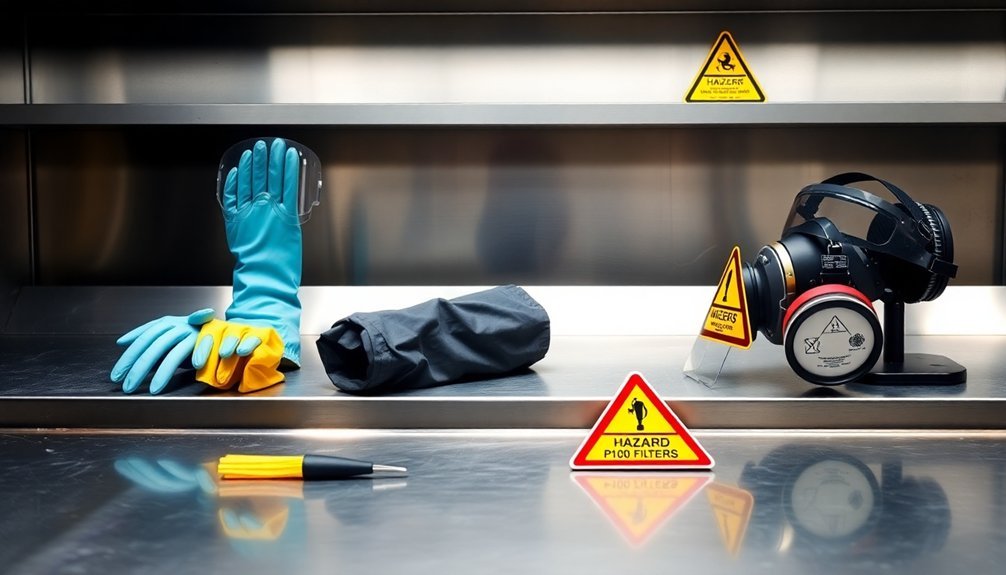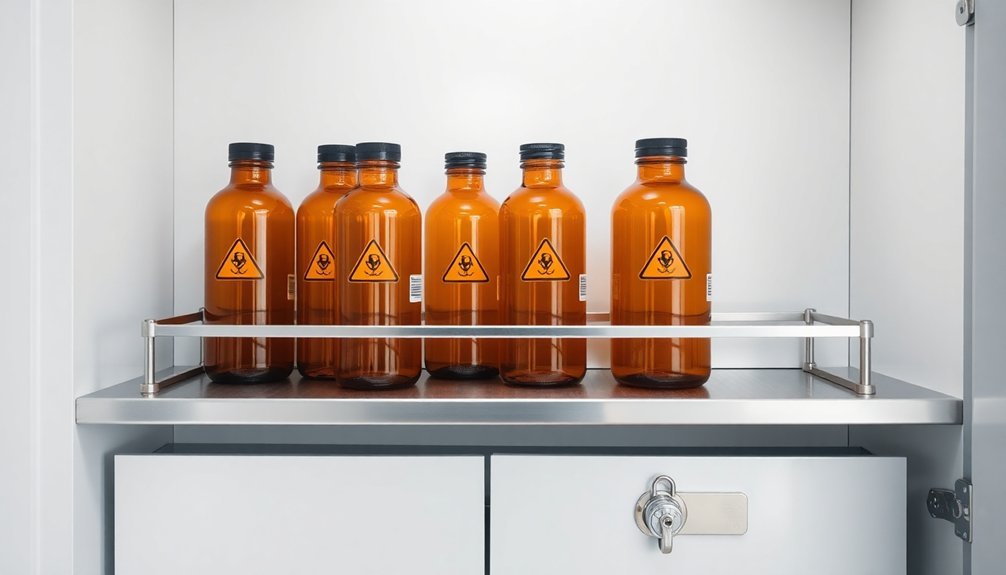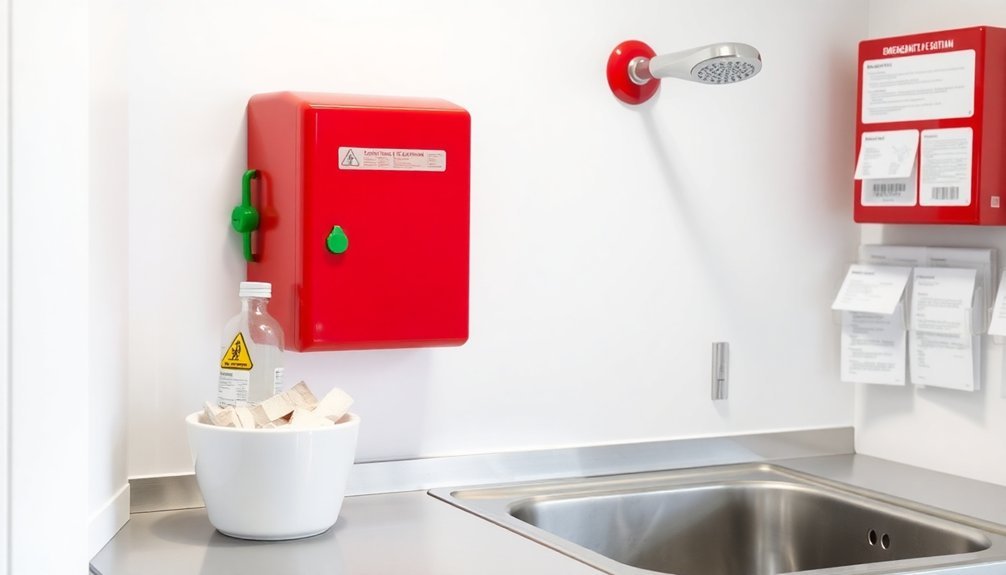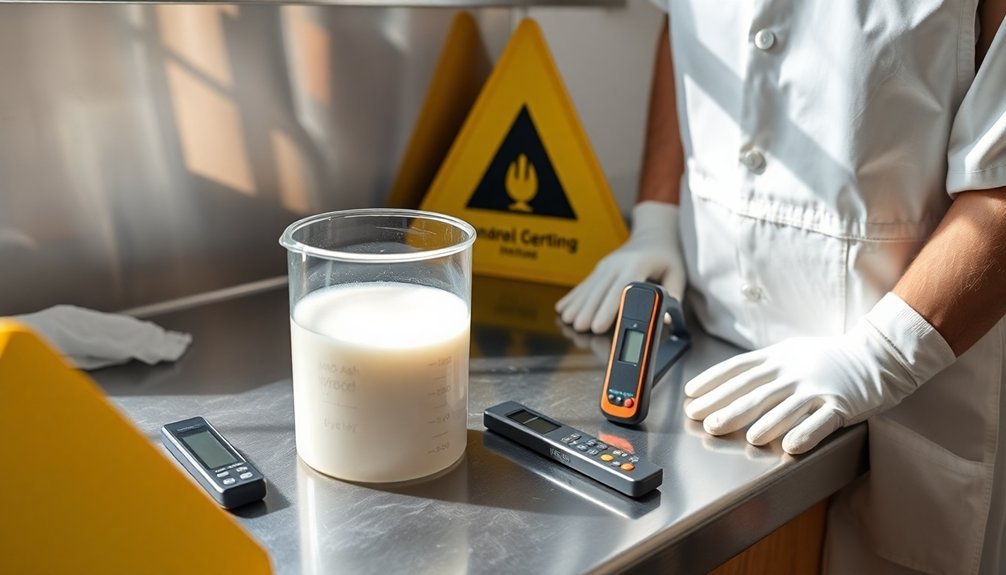When handling wood ash lye, you'll need proper protective gear including rubber gloves, safety goggles, long sleeves, and closed-toe shoes. Always work in a well-ventilated area and keep children and pets away. Store the lye in clearly labeled, durable containers and never mix with aluminum or copper utensils. Have emergency supplies ready, including water for burns and vinegar for neutralization. Keep accurate measurements and maintain a clean workspace. These basic rules just scratch the surface of safe lye handling.
Essential Protective Gear for Handling Wood Ash Lye

When working with wood ash lye, proper protective gear serves as your first line of defense against its caustic nature.
You'll need either rubber gloves or nitrile gloves to prevent skin burns, and safety goggles to shield your eyes from dangerous splashes that could cause blindness.
Don't forget to wear long sleeves and pants to minimize skin exposure to the caustic substance.
Long sleeves and pants aren't optional when handling caustic substances – they're essential barriers between your skin and potential chemical burns.
For complete lye safety, you should also wear an apron to protect your clothing and a surgical mask to avoid inhaling harmful fumes during the mixing process.
It's vital that all your protective gear is made of lye-resistant materials, as some items might break down when exposed to caustic substances.
Proper Workspace Ventilation Requirements

Three key ventilation practices are essential when working with wood ash lye.
You'll need to guarantee your workspace remains well-ventilated throughout the entire process to prevent harmful fume buildup. For maximum safety precautions, consider taking these critical steps:
- Open all available windows and position fans strategically to create cross-ventilation, dispersing any lye fumes that may accumulate during mixing and boiling.
- Move your work outdoors whenever possible, as this provides natural ventilation and minimizes exposure to concentrated vapors.
- Install a ventilator or air filter in enclosed spaces to maintain good air quality.
Monitor your workspace atmosphere constantly while working with lye.
If you notice strong fumes or experience any respiratory discomfort, step outside immediately for fresh air.
Keep children and pets away from the area to maintain focus on safety procedures.
Safe Storage and Labeling Protocols

Proper storage and labeling of wood ash lye can mean the difference between safety and disaster in your home workspace.
You'll need to store your lye in clearly labeled containers made from durable materials like glass or HDPE to prevent accidental spills. Don't forget to include hazard symbols on your containers to warn others of the caustic contents inside.
Keep your lye in a secure, locked cabinet where children and pets can't access it.
It's crucial to maintain an inventory log tracking preparation dates and expiration times for all your lye supplies.
Never reuse lye containers for other purposes, as this could lead to dangerous mix-ups.
Emergency Response and First Aid Measures

Despite careful handling, accidents with wood ash lye can occur, so you'll need to know exactly how to respond in an emergency.
Keep these critical first aid measures ready for immediate action:
- For skin contact: Immediately flush with plenty of water for 15 minutes and seek emergency medical assistance if burns develop.
- For eye exposure: Continuously rinse eyes with clean water for 15 minutes and get immediate professional help to prevent vision damage.
- For inhalation: Move to fresh air quickly and monitor breathing.
Never induce vomiting if someone swallows lye – instead, have them drink water or milk and call for emergency help right away.
While vinegar works as a neutralizing agent, don't apply it directly to lye spills, as this can create dangerous heat reactions and worsen injuries.
Correct Mixing and Handling Procedures

When mixing wood ash lye, you'll need to work in an area completely inaccessible to children and pets to prevent accidents.
You should monitor your water temperature with a thermometer while mixing, as excessive heat can create dangerous steam and increase reactivity.
Keep splashing to a minimum by stirring slowly and steadily with a long-handled spoon, maintaining a safe distance from the solution.
Mix Away From Children
Since wood ash lye is highly caustic, you'll need to establish a dedicated mixing area that's completely off-limits to children and pets.
When mixing lye, always wear protective gloves and goggles to shield yourself from dangerous splashes and spills. Guarantee you're working in a well-ventilated space to prevent inhaling harmful fumes.
For maximum safety when handling lye around children:
- Create a designated mixing station in an area children can't access, like a locked workshop or garage.
- Store all lye materials and equipment in childproof containers placed on high shelves or in locked cabinets.
- Use only heat-resistant, durable mixing containers to prevent breakage and potential exposure.
Remember to maintain strict safety protocols even after you've finished mixing, as residual lye can remain hazardous to curious children who might explore your work area.
Control Water Temperature Carefully
Because temperature control directly affects safety when making wood ash lye, you'll need to follow precise mixing procedures to prevent dangerous reactions.
Start with cool distilled water below 70°F (21°C), and never add water to lye – always add wood ash to the water instead. This prevents violent eruptions and dangerous splashing that could harm you.
Keep a thermometer handy to monitor the mixture's temperature throughout the process. You'll want to stir slowly and continuously as you add the ash, which helps distribute heat evenly and prevents hot spots from forming.
Don't rush this step – proper mixing is essential for safety. Once you've combined everything, let the lye solution cool completely before handling it. The cooler temperature will reduce the risk of chemical burns to your skin and eyes.
Stir Without Splashing Liquid
Proper stirring technique plays a key role in preventing dangerous splashes while making wood ash lye. You'll need to approach the mixing process with careful attention to safety, wearing your gloves and protective gear throughout the entire procedure.
To safely stir your lye solution:
- Add lye gradually to water while gently stirring with a long-handled spoon, keeping your hands at a safe distance to prevent splash exposure.
- Move your mixing tool in controlled, deliberate motions – avoid aggressive stirring that creates bubbles or turbulence.
- Keep your workspace clear and organized so you can focus entirely on the stirring process without distractions.
Remember to maintain a steady, gentle motion when mixing. This measured approach helps prevent splashing while ensuring the lye incorporates properly into the water.
Chemical Reaction Awareness and Prevention
Understanding chemical reactions is critical when working with wood ash lye, as even small mistakes can lead to dangerous situations. You'll need to understand the basic rules: always add lye to water to prevent dangerous eruptions, and wear personal protective equipment to guard against heat and fumes generated during the chemical reaction.
| Safety Concern | Prevention Method |
|---|---|
| Heat Generation | Use heat-resistant containers |
| Chemical Fumes | Work in ventilated areas |
| Reactive Substances | Store away from acids |
Remember to mix your lye solution in appropriate containers made of glass or sturdy plastic, as metal can react with the mixture. You'll want to avoid creating hazardous situations by keeping your lye storage area free from acids and other reactive materials. The chemical reaction produces significant heat, so don't skip any safety precautions when handling the mixture.
Tools and Equipment Safety Standards
When working with wood ash lye, selecting the right tools and equipment serves as your first line of defense against accidents.
Proper tool selection is crucial for safely handling wood ash lye – it's your primary safeguard against dangerous chemical accidents.
You'll need durable containers made of glass or sturdy plastic to safely handle the exothermic reaction. It's essential that you avoid aluminum, cast iron, and copper utensils as they'll react dangerously with the alkaline solution.
Important safety measures you must follow:
- Wear proper personal protective equipment including gloves and goggles, long sleeves, and closed-toe shoes
- Use dedicated mixing tools that you've thoroughly cleaned and marked for lye use only
- Maintain a clean workspace with all equipment readily accessible
Remember to designate specific tools for your lye-making process and never use them for other purposes.
This systematic approach to equipment safety will help prevent contamination and reduce accident risks.
Disposal Methods and Environmental Considerations
Safe disposal of wood ash lye requires careful attention to both local regulations and environmental impact.
You'll need to carefully dispose of wood ash lye to prevent environmental harm and maintain community safety standards.
Don't pour the solution down drains or toilets, as it can cause serious plumbing issues and disrupt wastewater treatment systems. Instead, neutralize small quantities with vinegar before disposal, which reduces its caustic properties.
If you're an avid gardener, you can add moderate amounts to your compost pile, where it provides beneficial nutrients like potassium to enrich your soil.
Always store any leftover wood ash lye in a secure container with clear labels until you're ready for proper disposal.
Check your local waste management guidelines to verify you're following the correct procedures for your area.
Safe Testing and Measurement Guidelines
Testing wood ash lye requires precise measurement tools and systematic procedures to confirm both safety and consistent results.
You'll need to accurately measure the alkalinity using a pH meter or titration method, as these provide more reliable data than traditional tests.
When testing lye concentration, follow these essential steps:
- Clean your equipment thoroughly to prevent contamination that could affect your measurements.
- Weigh your wood ash and distilled water precisely to maintain proper ratios for soap making.
- Use a hydrometer to check the solution's density before proceeding with your project.
Document all your measurements and test results in a logbook.
This practice helps you track your success rates and improve future batches.
Neutralization and Spill Management Techniques
Despite its usefulness in soap making, wood ash lye requires careful handling and immediate action if spills occur.
Wood ash lye is a valuable soapmaking ingredient, but its caustic nature demands swift response and proper safety measures during accidents.
When you're dealing with lye spills, you'll need to choose your neutralization method based on the spill's size and form.
For small solution spills, use paper towels to wipe the area, while larger spills require non-clumping kitty litter for absorption. If you're handling granular lye, sweep it up and mix with cold water.
While vinegar can neutralize lye, you'll need a large quantity, and the reaction creates intense heat.
Don't forget to wear protective gear, including gloves and goggles, to prevent exposure to caustic residues.
After cleaning up, wait two days before final surface cleaning to allow the lye to become inert and protect your plumbing.
Frequently Asked Questions
How to Handle Lye Safely?
You'll need rubber gloves, goggles, and long sleeves. Always add lye to water slowly, work in ventilated areas, and keep vinegar nearby. Don't use metal containers, and avoid skin contact completely.
What Containers Are Safe for Lye?
You'll need glass or HDPE plastic containers that are heat and chemical-resistant. Use Pyrex glass for best results. Don't use metal containers like aluminum or copper as they'll react dangerously with lye solutions.
What Happens When You Mix Wood Ash, and Water?
When you mix wood ash and water, you'll create a caustic lye solution that's highly alkaline. It generates heat during the reaction and forms sodium hydroxide and potassium carbonate compounds that can burn skin.
What Not to Mix With Lye?
You shouldn't mix lye with aluminum containers, acids like vinegar, organic materials before proper preparation, or add water to lye. Never combine it with food items. Always add lye to water, not reverse.
In Summary
Following these safety rules for wood ash lye isn't just about protecting yourself – it's about ensuring everyone's wellbeing. You'll need to stay vigilant with proper gear, ventilation, and handling procedures. Remember to store your lye safely, maintain clear labels, and know your emergency protocols. By making safety your top priority, you're creating a secure environment for working with this powerful substance.





Leave a Reply